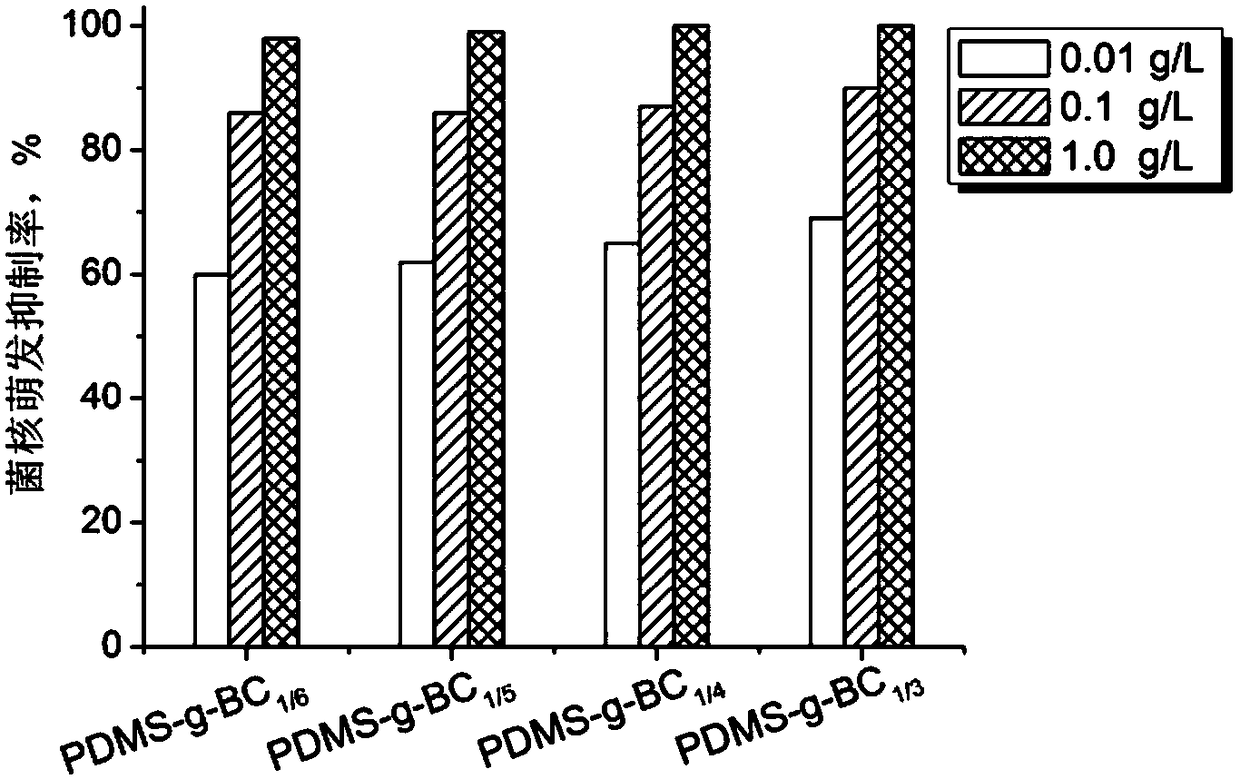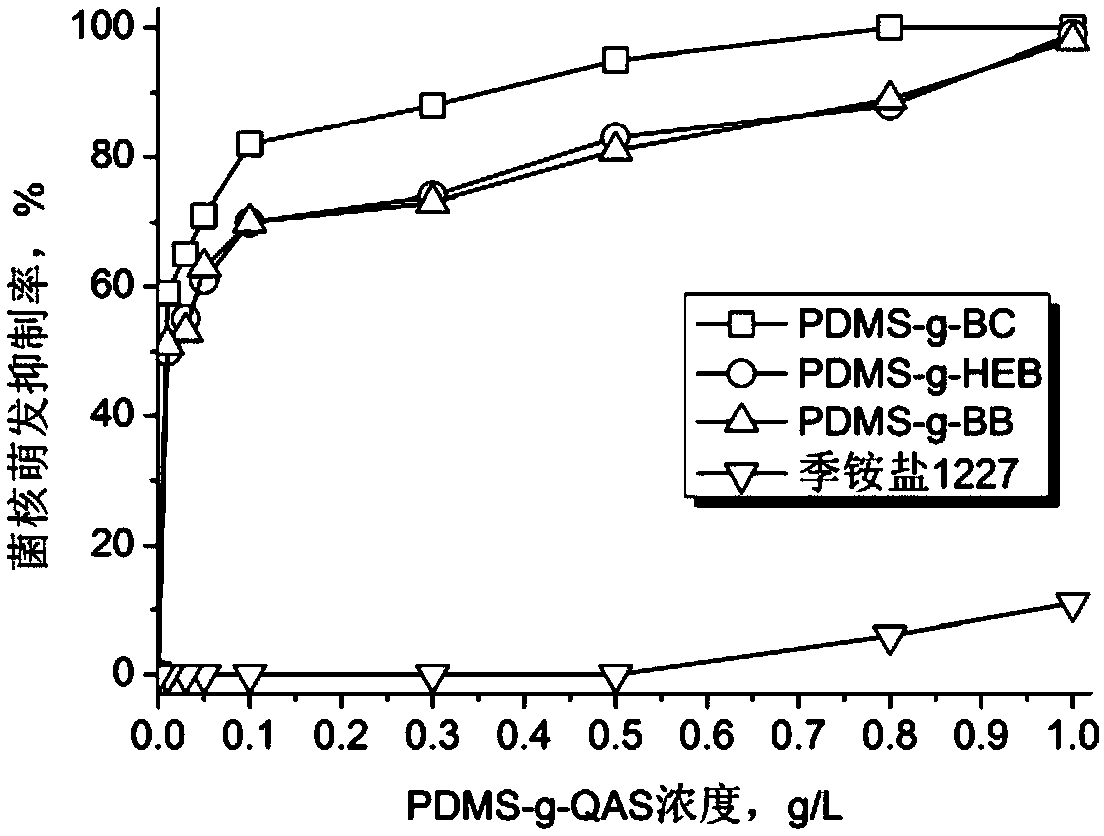Application of Macromolecular Quaternary Ammonium Salt in Inhibiting Sclerotia Germination of Rice Sheath Blight
A technology of rice sheath blight and quaternary ammonium salts, applied in the field of inhibiting rice sheath blight sclerotia germination, can solve the problems that rice sheath blight cannot be prevented and completely eradicated, and achieve easier biodegradation, quaternary ammonium The effect of increased salt concentration and strong penetration
- Summary
- Abstract
- Description
- Claims
- Application Information
AI Technical Summary
Problems solved by technology
Method used
Image
Examples
Embodiment 1
[0028] Graft benzyl ammonium chloride (PDMS-g-BC, such as figure 1 Shown in A) the method that aqueous solution suppresses rice sheath blight bacteria sclerotia germination, comprises the steps:
[0029] (1) Preparation of macromolecular quaternary ammonium salt solution: Weigh a certain amount of polysiloxane grafted benzyl ammonium chloride (PDMS-g-BC, number average molecular weight is 2.4×10 3 , the grafting rate of quaternary ammonium salt is 1 / 5, and its specific preparation method refers to the literature "LinYaling, Liu Qiongqiong, Cheng Liujun, Lei Yufeng, Zhang Anqiang. Synthesis and antimicrobial activities of polysiloxane-containing quaternary ammonium saltson bacteria and phytopathogenic fungi. Reactive & Functional Polymers ,2014,85:36-44.” or “Liu Qiongqiong. Synthesis and Characterization of High Molecular Quaternary Ammonium Salts and Their Inhibitory Properties to Bacteria and Fungi; Master Thesis of South China University of Technology, 2014”; Tetrasiloxane...
Embodiment 2
[0035] n-Butylammonium bromide (PDMS-g-BB, such asfigure 1 Shown in B) the method that aqueous solution suppresses rice sheath blight bacteria sclerotia germination is basically the same as embodiment 1, and difference is only: the macromolecular quaternary ammonium salt in the step (1) is polysiloxane graft n-butyl bromide Ammonium chloride (PDMS-g-BB, number average molecular weight is 3.0×10 3 , the grafting rate of quaternary ammonium salt is 1 / 6, and the specific preparation method refers to the literature "Lin Yaling, Liu Qiongqiong, Cheng Liujun, Lei Yufeng, ZhangAnqiang. Synthesis and antimicrobial activities of polysiloxane-containingquaternary ammonium salts on bacteria and phytopathogenic fungi. Reactive & Functional Polymers ,2014,85:36-44.” or “Liu Qiongqiong. Synthesis and Characterization of High Molecular Quaternary Ammonium Salts and Their Inhibitory Properties to Bacteria and Fungi; Master Thesis of South China University of Technology, 2014”; Tetrasiloxane (...
Embodiment 3
[0037] Graft n-hexylammonium bromide (PDMS-g-HEB, such as figure 1 Shown in C) the method that aqueous solution suppresses rice sheath blight bacterium sclerotium germination is basically the same as embodiment 1, and difference is only: the macromolecular quaternary ammonium salt in the step (1) is polysiloxane graft n-hexyl bromide Ammonium (PDMS-g-HEB, number average molecular weight 2.5×10 3 , the grafting rate of quaternary ammonium salt is 1 / 4, and the specific preparation method refers to the literature "Lin Yaling, Liu Qiongqiong, Cheng Liujun, Lei Yufeng, ZhangAnqiang. Synthesis and antimicrobial activities of polysiloxane-containingquaternary ammonium salts on bacteria and phytopathogenic fungi. Reactive & Functional Polymers ,2014,85:36-44.” or “Liu Qiongqiong. Synthesis and Characterization of High Molecular Quaternary Ammonium Salts and Their Inhibitory Properties to Bacteria and Fungi; Master Thesis of South China University of Technology, 2014”; Tetrasiloxane (...
PUM
 Login to View More
Login to View More Abstract
Description
Claims
Application Information
 Login to View More
Login to View More - R&D
- Intellectual Property
- Life Sciences
- Materials
- Tech Scout
- Unparalleled Data Quality
- Higher Quality Content
- 60% Fewer Hallucinations
Browse by: Latest US Patents, China's latest patents, Technical Efficacy Thesaurus, Application Domain, Technology Topic, Popular Technical Reports.
© 2025 PatSnap. All rights reserved.Legal|Privacy policy|Modern Slavery Act Transparency Statement|Sitemap|About US| Contact US: help@patsnap.com



